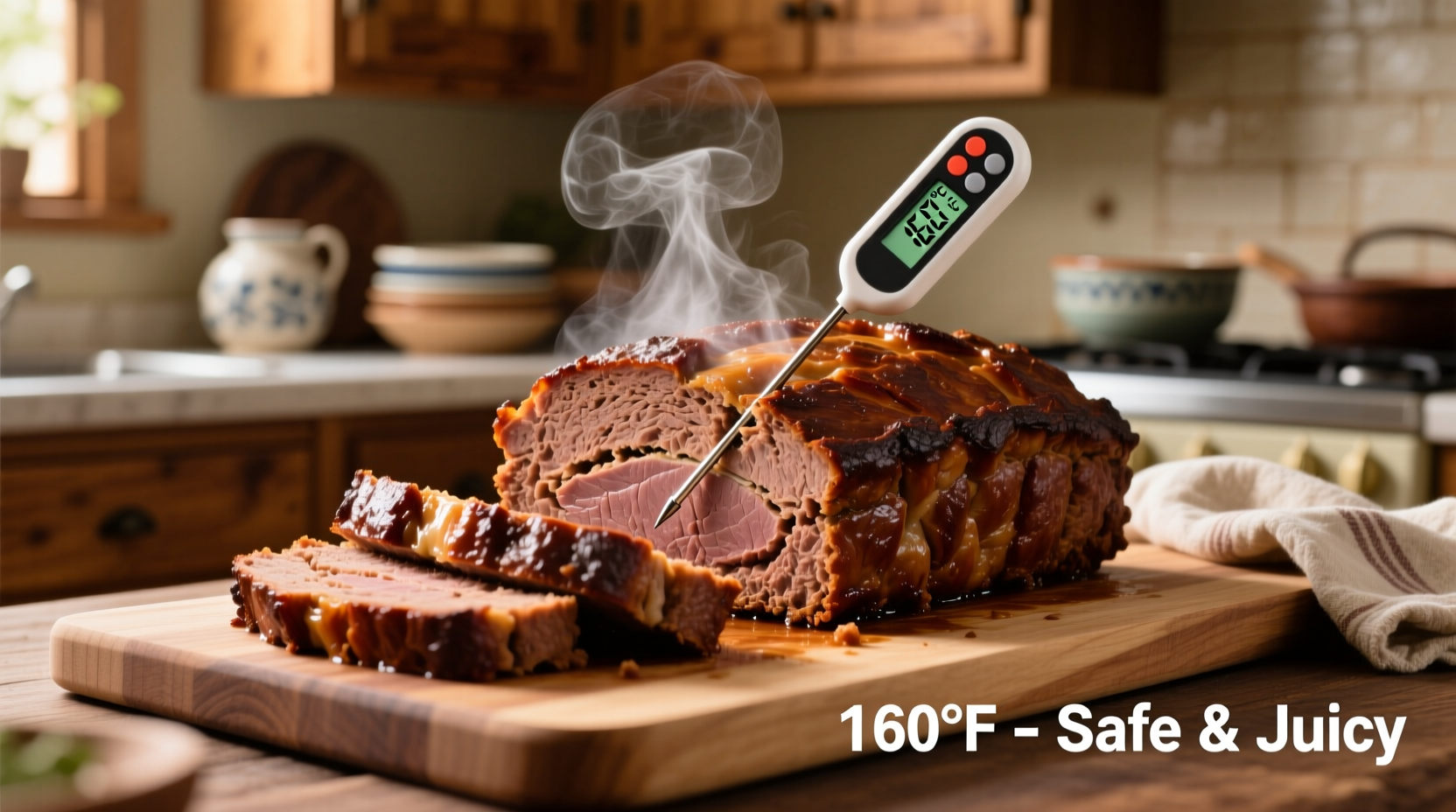Meatloaf must reach an internal temperature of 160°F (71°C) to be safely cooked and ready to eat. This precise temperature kills harmful bacteria while preserving moisture and flavor in ground meat dishes.
Discover exactly when your meatloaf is perfectly cooked with science-backed temperature guidelines that prevent foodborne illness while ensuring juicy, flavorful results. This guide cuts through confusing advice to give you the single most reliable method for determining meatloaf doneness—no guesswork required.
Why 160°F Is the Critical Meatloaf Temperature
Unlike whole cuts of meat where surface cooking eliminates pathogens, ground meats like meatloaf require thorough internal cooking. The USDA Food Safety and Inspection Service mandates 160°F (71°C) as the minimum safe temperature for all ground beef products. This critical threshold destroys dangerous bacteria like E. coli and Salmonella that can cause serious foodborne illness.
"Ground meat's increased surface area allows bacteria to spread throughout the mixture," explains food safety expert Dr. Mindy Brashears, former USDA Deputy Under Secretary for Food Safety. "Cooking to 160°F ensures complete pathogen elimination in meatloaf and other ground meat dishes."
| Meat Type | Safe Minimum Internal Temperature | Resting Time |
|---|---|---|
| Ground Beef (Meatloaf) | 160°F (71°C) | 3 minutes |
| Ground Poultry | 165°F (74°C) | 3 minutes |
| Beef, Pork, Veal, Lamb Steaks | 145°F (63°C) | 3 minutes |
| Poultry Breasts | 165°F (74°C) | None |
Source: USDA FoodSafety.gov temperature guidelines updated September 2024
How to Accurately Check Meatloaf Temperature
Proper thermometer placement determines whether you get an accurate reading:
- Use an instant-read digital thermometer - Dial thermometers lack the precision needed for meatloaf
- Insert probe into the center - Position horizontally through the side to reach the thickest part
- Avoid contact with pan or bones - Metal surfaces give false high readings
- Check multiple spots - Meatloaf's irregular shape creates temperature variations
"Many home cooks make the mistake of checking temperature only once near the edge," notes Antonio Rodriguez, culinary specialist. "Meatloaf's dense structure means the center lags behind outer portions. Always verify temperature in at least three different central locations."

Common Meatloaf Temperature Mistakes
Avoid these frequent errors that compromise safety or quality:
- Guessing doneness by color - Pink hues can persist even at safe temperatures due to myoglobin
- Using visual cues alone - Juices running clear indicates approximately 150°F, still unsafe for ground meat
- Removing too early - Meatloaf continues cooking 5-10°F during resting (carryover cooking)
- Overcooking for safety - Exceeding 170°F guarantees dry, crumbly texture
Special Considerations for Different Meatloaf Variations
While 160°F remains the universal standard for beef-based meatloaf, certain variations require attention:
- Poultry meatloaf - Must reach 165°F (74°C) due to higher salmonella risk in ground poultry
- Meatloaf with stuffing - Both meat mixture and stuffing must hit their respective safe temperatures
- Glazed meatloaf - Apply sugar-based glazes during last 15-20 minutes to prevent burning
Commercial meatloaf products often contain binders and preservatives that alter cooking dynamics. Always follow package instructions when using pre-made mixes, though independent verification with a thermometer remains essential.
The Critical Resting Period
After reaching 160°F, let meatloaf rest covered with foil for 10-15 minutes. This crucial step allows:
- Temperature equalization throughout the loaf
- Juice redistribution for maximum moisture retention
- Carryover cooking to complete pathogen elimination
- Easier slicing without structural collapse
Cutting immediately causes precious juices to escape, resulting in dry, crumbly texture despite proper cooking temperature. This resting principle applies whether you're making classic beef meatloaf, turkey meatloaf, or vegetarian alternatives.
Practical Temperature Verification Tips
Ensure thermometer accuracy with these professional techniques:
- Calibrate regularly - Use ice water (32°F/0°C) or boiling water (212°F/100°C at sea level) test
- Clean between readings - Prevent cross-contamination with hot soapy water
- Track temperature rise - Note how quickly meatloaf approaches 160°F for future reference
- Use leave-in probes - For ovens without windows, monitor progress without heat loss
Remember that altitude affects boiling points and slightly alters cooking dynamics. At elevations above 3,000 feet, increase meatloaf resting time by 5 minutes to compensate for lower atmospheric pressure.











 浙公网安备
33010002000092号
浙公网安备
33010002000092号 浙B2-20120091-4
浙B2-20120091-4